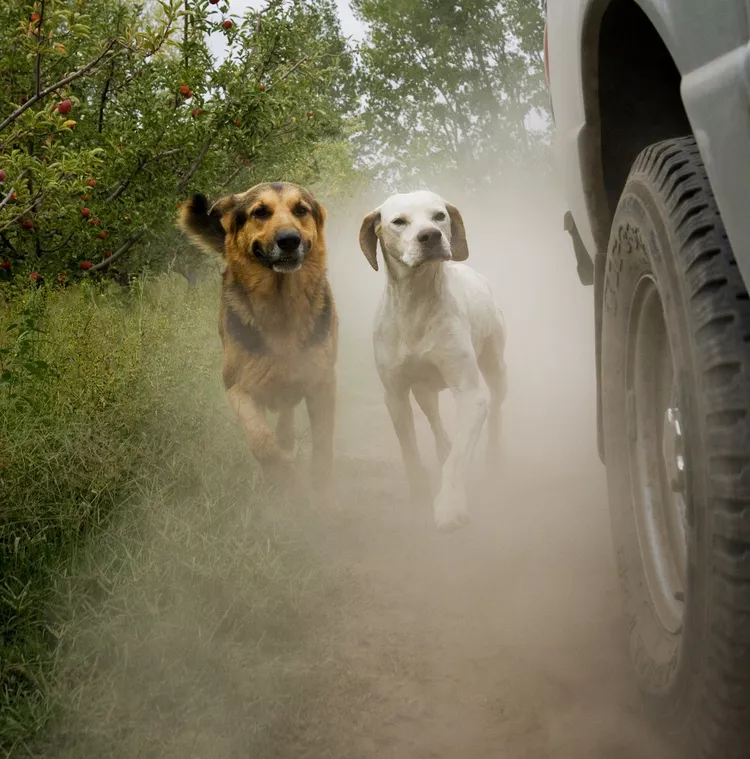How to Train Your Dog Not to Chase

Dogs are naturally wired to chase cars and other moving objects. When they don’t have appropriate outlets or training, they chase bicycles or even cats or kids. Chasing some things, though, can get dogs into trouble with owners, the neighbors, or even get them hurt or killed. Learn how to train your dog to stop chasing.
Why Dogs Chase
Dogs evolved as endurance specialists. Wild canines, like wolves and coyotes, use speed to run down prey. Domesticated dogs are but one step away from their wild cousins and have retained this instinct to run. The urge to pursue moving objects is hard-wired into the canine brain. This is a natural hunting behavior that is demonstrated whenever your pup chases a ball, Frisbee, or squirrel.
Through selective breeding, people have redirected these hunting instincts so that the Labrador stops short of a killing bite and instead retrieves the prey with a soft mouth, for example. Herding breeds continue to feel compelled to chase after and “push” moving objects like sheep in a specific direction.
Consider Your Dog's Breed
All dogs enjoy the chase, but particular breeds developed for specific kinds of work are typically more obsessive than others. Consider your dog's breed if you have to have chasing issues. Greyhounds, whippets, and most terriers are attracted to pursuing and even attacking small animals. These breeds can pose a danger to cats, smaller dogs, or farm animals like chickens or rabbits. Shepherd breeds are more likely to chase larger livestock, as well as cars, bicycles, and jogging people in a misguided effort to herd them.
Before You Train Not to Chase
To teach what not to chase, your pup must first be trained to leash walk nicely and to understand the "sit" and "stay" commands. These are essential in keeping your dog where you want it. Once those are mastered, your dog can learn not to chase.
How to Train Your Dog to Sit
Expose Your Dog to Staged Situations
The goal is to expose your dog to staged situations that prompt chasing behavior, such as livestock or cars. Place your pup on a 6-foot leash (as a safety precaution should the dog bolt), and give the sit/stay command. Next, have a friend slowly ride a bicycle, drive a car, or jog by the pup, while you continue to enforce your puppy's sit/stay position.
Distract and Reward
Distract your dog with a food reward, praising it for not chasing. As soon as it begins to agitate about running after (whining, growling), make an about-face and walk the other direction while praising and offering treats. You want the pup to associate the car/bike/jogger presence with treats as it walks away from the enticement.
Continue to Practice
Gradually increase the speed of the passerby, and continue to intermittently reward your pup for sitting still as it approaches, and then turning away to get treats once it’s near. Drill with these setups over and over until the dog looks at you after he sees the passerby rather than wanting to approach and chase. It's impossible to totally eliminate the chasing behavior, but it can be redirected.
Reduce Opportunities for Chasing
Enforce appropriate boundaries for your dog: A fenced yard or leash confinement when off your property teaches it the rules and prevents it from chasing livestock or other off-limits objects. Obedience training is necessary if you are to control your pup's bad habits.
Provide Safe Outlets for Chasing
Give your puppy alternatives to satisfy this normal urge. Interactive games such as fetch alleviate the urge to chase and provide a bonding experience for the two of you. Relieving your puppy’s boredom can help avoid chase behaviors that arise from frustration and loneliness. There are also organized dog sports such as herding trials for shepherd breeds, lure-coursing for sighthound breeds, and go-to-ground for terriers that reward these innate behaviors in controlled settings.
How to Train Your Dog to Fetch
Problems and Proofing Behavior
The owner of a dog that chases inappropriately is liable if the dog hurts someone or damages property. The chasing dog is also at risk of being injured or killed if it chases a car, or by the other animal or person defending themselves. In some areas, property owners are within their rights to shoot dogs that harass livestock.
You'll want to be able to redirect your dog's urge to chase with any sudden stimulant, so be sure to practice this technique with a variety of passersby. If you practiced first with a bike passing, try it with a slow-moving car, and have someone repeat the exercise while jogging. Be sure to always secure your dog's leash when an unfamiliar type of passerby is near, and never let your dog chase with a long leash on and then hit the end of the leash at a full-on run. This can severely damage your dog's neck and vertebrae.
If your dog continues to chase even after training, you may want to speak with a canine behavioral specialist. Chasing behavior can be dangerous (or deadly) for the dog, especially if your dog likes to chase cars. A specialist may be able to help identify issues, breed habits, or something else that is causing your dog to constantly chase.